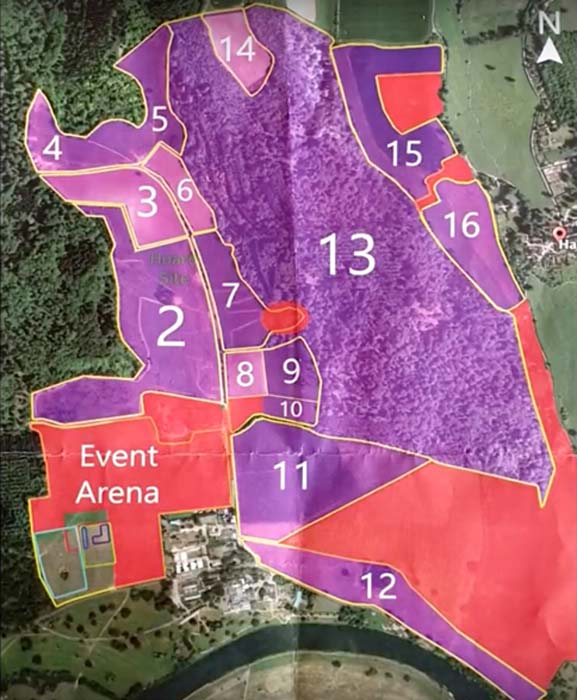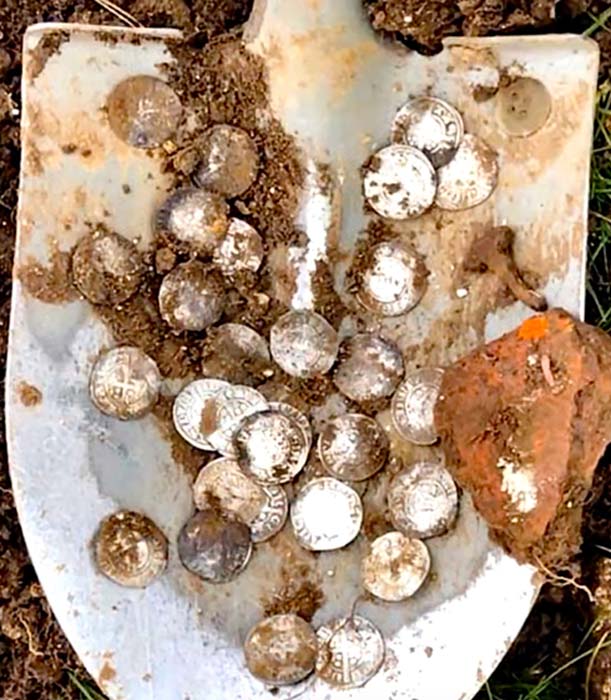The ‘Hambleden Hoard’, found by four amateur metal detectorists partaking in a four day long rally in Buckinghamshire, England, has now been declared treasure by the coroner, meaning they will now be in line for a hefty payday. In 2019, the team unearthed over 550 rare gold and silver coins, including 12 ‘extremely rare’ gold coins from the time of the Black Death. It is the biggest coin hoard to have been unearthed in the UK in over a decade.
Believed to have been stashed more than 600 years ago according to an article in The Daily Mail, the coins are estimated to be potentially worth £150,000 ($195,000). This is the biggest recovered gold hoard since the 2011 mid-17th century discovery of 52 coins in High Ackworth, West Yorkshire and the most valuable silver hoard discovered since the 617 coins dated to the early 10th century unearthed near Harrogate, North Yorkshire.

The Hambleden Hoard was discovered at site 6. (Suffolk Sifter – Detectorist / YouTube)
The Discovery of the Hambleden Hoard
Over four days the group of successful metal detectorists; Andrew Winter, brothers Tobiasz and Mateusz Nowak, and Dariusz Fijalkowski scoured a field near Hambleden, a village recorded in the 1086 AD Domesday Book. They excavated a total of 557 coins and among the first finds made in what has been nicknamed the ‘Hambleden Hoard’, were “12 ornately decorated silver Edward I and II coins” created in the reign of Edward I and II – 1272 to 1327 AD.
On the first day they also found nine gold nobles and 276 silver coins which are described as a “rare mintage mix from Lincoln, Birmingham, Ireland, and Scotland.” Mr. Winter, a forklift and crane driver from Blyth, said “I swung around my machine and all the silver coins were coming in at number 16 on the screen – this indicates a hammered silver coin.” Then, his appliance showed the elusive ‘21’ signal for gold and when they dug up the turf they first discovered two coins but could see many more in the pit.

On the first day they also found nine gold nobles and 276 silver coins. (Suffolk Sifter – Detectorist / YouTube)
Having dug up hundreds of coins the four men became so paranoid over the security of their discovery that “they slept in tents” to protect the coins from thieves. Speaking of the find, Mr. Mateusz, a hospital cleaner from Newcastle, told reporters “It was a miracle moment after moment for everyone…It felt unreal”. And their team mate Mr. Tobiasz Nowak, a Newcastle baker, said “I can’t even imagine how we got so lucky.”
Buckinghamshire And the Fields of Dreams
A BBC article published in January 2015 describes another gang of metal detector enthusiasts in Buckinghamshire who uncovered one of biggest hoards of coins ever found in Britain. In this instance, detectorist Paul Coleman from the Weekend Wanderers Detecting Club was exploring a field near Aylesbury and dug up a lead bucked filled with more than 5,000 11th century coins depicting the heads of kings Ethelred the Unready and Canute from the late Anglo Saxon – early Norman period.
While that discovery was ‘one of’ the largest UK hoards, an earlier 2009 BBC article details ‘the’ largest Anglo Saxon treasure ever found in Britain. Discovered in a field near Lichfield, Staffordshire in July 2009, metal detector enthusiast Terry Herbert found a 7th Century hoard of 1,600 items including sword pommels and parts of helmets and crosses valued at a cool £3.285m.
Whose Treasure Is the Hambleden Hoard?
In this case, the 545 silver coins are estimated to be worth between £20 and £50 ($25 to $65) each – with the 12 ‘exceptionally rare coins’ being valued at around £500 ($650) each and the full gold nobles might, according to Mr. Winter, be worth anything between £10,000 ($130,000) each. But who owns the coins?

12 exceptionally rare coins were part of the Hambleden Hoard find. (paul cee/ YouTube)
In England, Wales, and Northern Ireland the Treasure Act of 1996 states that “gold or silver finds older than 300 years” are rightfully the property of the crown and all such finds must be reported “within 14 days.” And under these British laws four or more coins are regarded as a ‘hoard’ and this means that the finder is legally obliged to declare their finds to the event organizers. But they will get a payout.
The hoard of Anglo-Saxon gold, silver, and garnet objects discovered in 2009 by Terry Herbert was acquired by the Birmingham Museum and Art Gallery and the Potteries Museum and Art Gallery in Stoke on Trent for $5.3 million. This sum was subsequently split between Herbert and the owner of the Staffordshire field where it was found, and so too when this new hoard is sold to a museum the four men who invested four days, will see a spectacular return.